Please scroll to the bottom of the page for the English version.
- 11月の日本一時帰国時に起きた奇跡
- 源兵衛さんがお話してくださった教科書には載っていない「日本の歴史」
- 現代人は物事を複雑化しすぎ。全てはシンプル。
- ただの観光地ではない本当の「京都」とは?
- 源兵衛さんへのインタビューの続きは第二弾で
- Interview with Mr. Yamaguchi Genbei, 10th Generation of the Esteemed 285-Year-Old Obi Manufacturing and Sales Company, Kondaya Genbei, in Kyoto Part 1
- The Miracle That Happened During My Temporary Return to Japan in November
- Genbei shared aspects of “Japanese history” that are not found in textbooks.
- The purpose of Japanese textiles is “dignity.”
- The reason “dignity” was held in high regard during the Heian period and the definition of “dignity” as “cultivation.”
- “Kabuki” originated as a place to purchase beautiful young men.
- During the Edo period, “Kabuki” served as a satirical medium to mock the shogunate.
- The origins and reasons behind “torn lattice,” “yakko kites,” and “tattoos.”
- It all started with a simple reason: “I want to be popular.”
- Modern people tend to complicate things too much. Everything is simple.
- What is the true essence of Kyoto, which is more than just a typical tourist destination?
- To Mr. Genbei, the continuation of the interview will be in Part 2
11月の日本一時帰国時に起きた奇跡
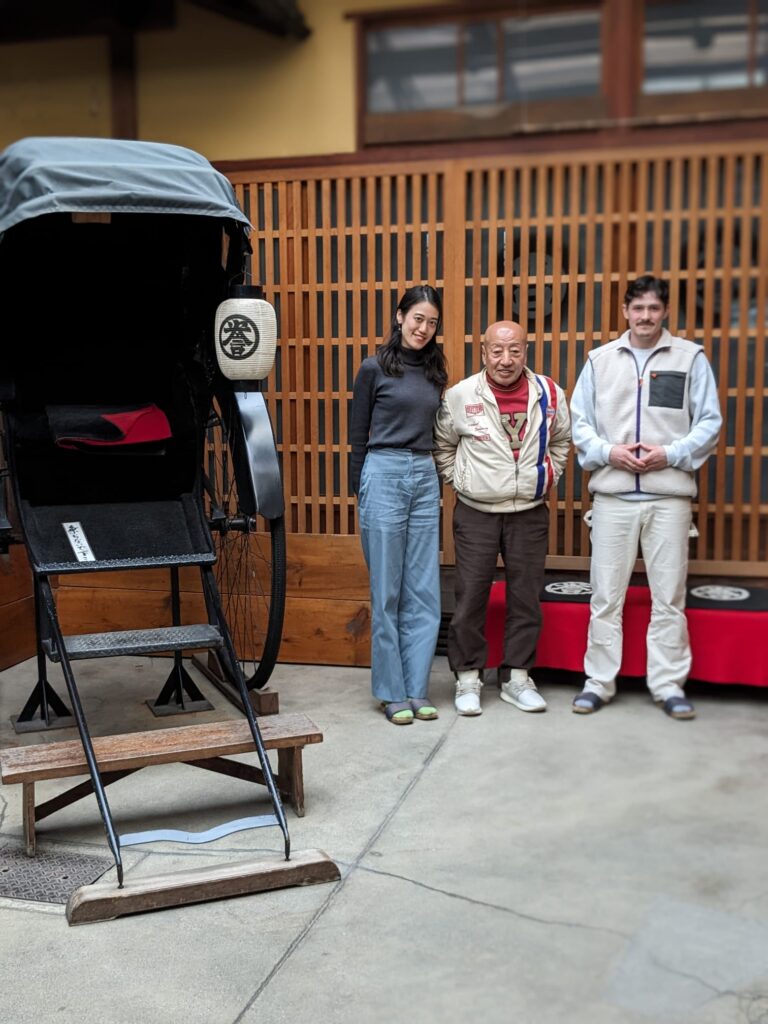
京都室町で創業約285年を迎える帯匠「誉田屋源兵衛」の十代目当主の山口源兵衛さん。
国内外に熱狂的信奉者がいらっしゃり、帯業界の異端児とも呼ばれているとか。
私が源兵衛さんのことを知ったのは、パートナージョセフが源兵衛さんの帯の動画をYoutubeで見つけたのがきっかけ。その動画で紹介されていた漆黒の生地にラピスラズリを使用して大胆に牡丹が織り込まれた帯を見た瞬間に虜になりました。
「誉田屋源兵衛」オフィシャルウェブサイト https://kondayagenbei.jp
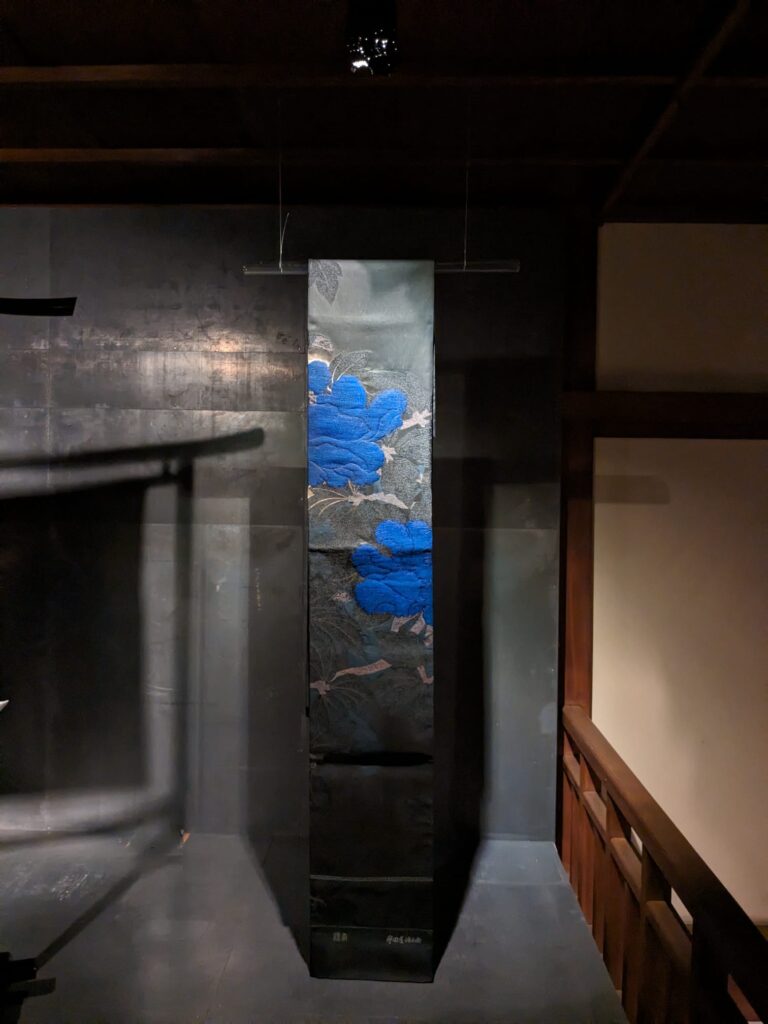
そしてその時に日本に一時帰国する際に、彼の帯を生で見ることを心に決めました。
11月の帰国時に京都に訪れた際に「誉田屋源兵衛」のオフィスに直接お電話したところ、タイミングや奇跡が重なり、幸運なことに通常一般公開されていない源兵衛さんの帯を直接拝見できることに!
さらにはなんと!その日は偶然にも源兵衛さんがにオフィスにいらっしゃるということで、直接インタビューをする時間をいただくことができました。お電話に出てくださった方も「奇跡だ」と何度もおっしゃられておりました。
貴重なお時間をいただいた源兵衛さんをはじめ「誉田屋源兵衛」のスタッフの皆様、そしてこの奇跡に心から感謝いたします。
今回の第一弾では帯について執筆する前に、まず源兵衛さんのインタビューでお聞きした日本の歴史、当時の人の思考回路や観光地ではない京都の真髄について書いていきます。
源兵衛さんがお話してくださった教科書には載っていない「日本の歴史」
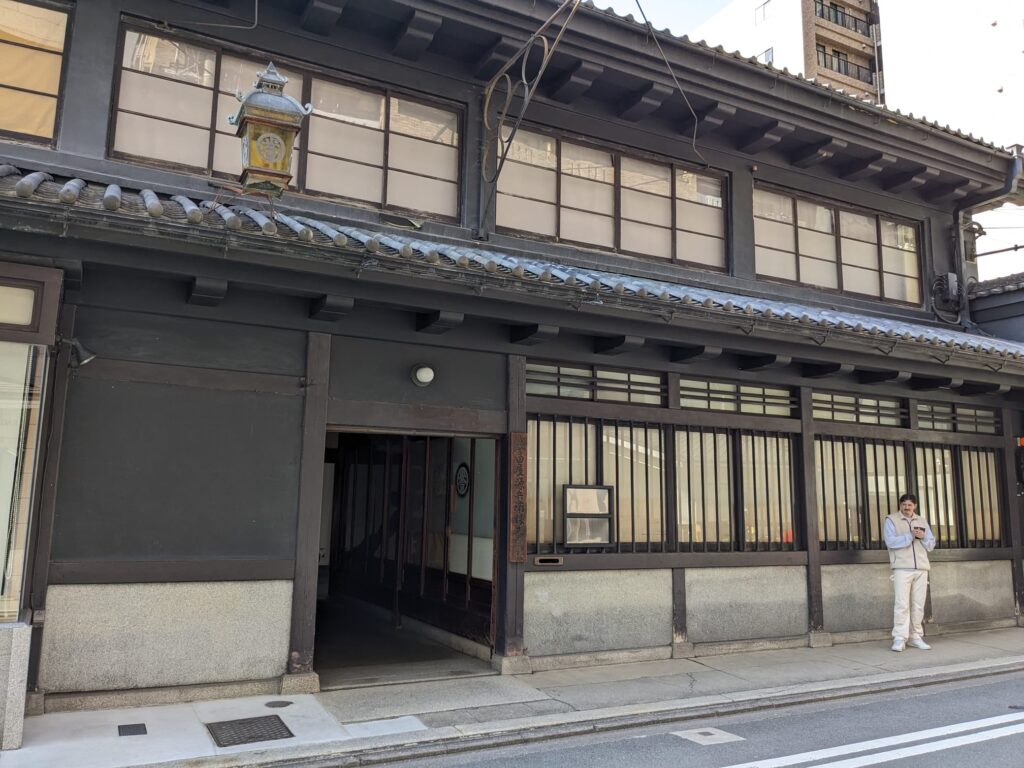
こちらが「誉田屋源兵衛」のオフィス兼スタジオ。趣深い日本家屋の奥に潜む薄暗い重厚感たっぷりの一室へ案内していただきました。そのお部屋の奥に座っていらっしゃった源兵衛さん。圧倒的なオーラと重低音ボイスに即引き込まれました。
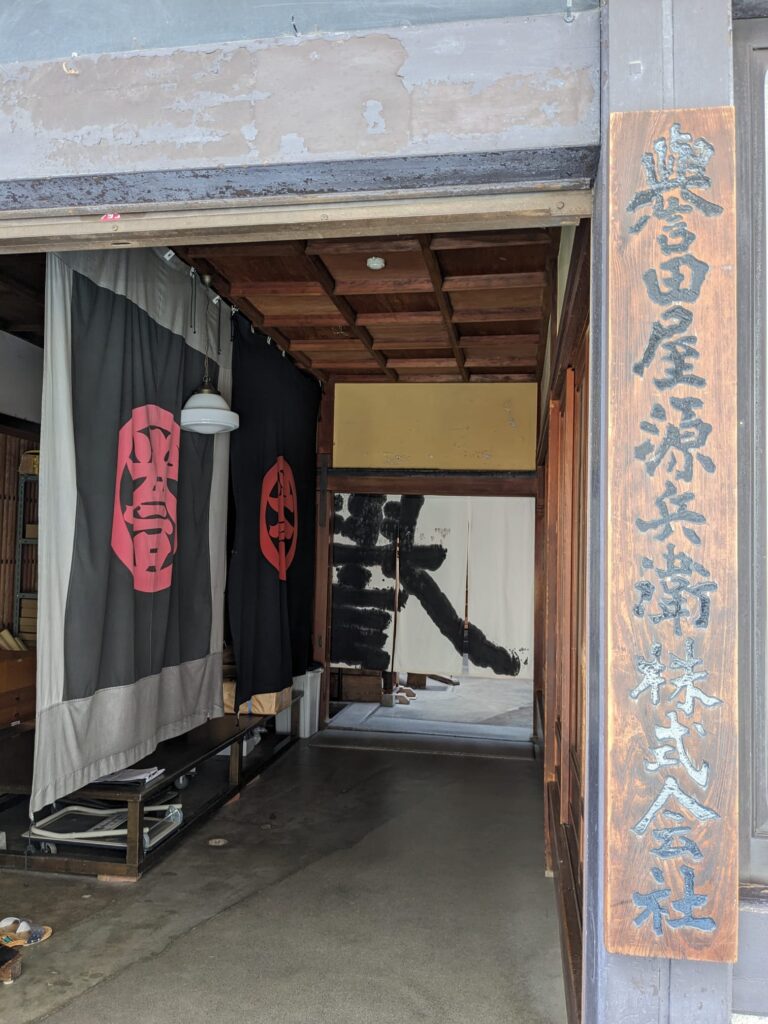
源兵衛さんに聞きたいことがありすぎて、事前に大量の質問を準備していったにも関わらず、それよりも遥かに興味深いお話をしてくださり質問が吹き飛びました。
私たちが到着するやいなや、まず「教科書には載っていない日本の歴史」からお話してくださいました。
日本の織物の目的は「品格」
源兵衛さん:日本の織物の目的は「品格」であったと言うことが残っている。平安時代ってすごい時代で。一部の貴族階級の人の話なんやけど、天皇が着ている物だけで、その織物の品格に皆んなの頭が下がっていった。
「品格」を表現するっていうのは凄いと思う。元々の織物とか紋様は中国崇拝なんですよ。遣隋使や遣唐使が色々なものを持って帰ってきたから。その時にどうしても向こうの日本にはないような花や植物がモチーフになってしまう。
ただ面白いのは、トラブルがあって中国との貿易を取りやめた時に日本風が生まれる。衣装が真似できなくなるから日本のアレンジが始まる。
本当の衣装が残っているのは桃山時代以降になってくる。ただ織田信長とか上杉謙信などの一部の人の衣装のみ。それが衣装史になってしまっているから。そのちょっと下の人たちが何を着ていたのかが分からない。だから文献や絵で推測するしかない。さらに平安時代の衣装は何も残っていない。
ただ平安時代に「品格」を頂点に置いていたのはよくわかる。
平安時代「品格」が頂点に置かれていた理由。そして品格とは「教養」
源兵衛さん:それは「武力」がなかったから。当時は武力より「情報や教養」が権力。武力は軽視されていたんよ。
私:「品格」とは何ではかるんですか?
源兵衛さん:「品格」とは「教養」なんよ。例えば中国をどれだけ知っているか。
私:だから平和な時代だったんですね。
源兵衛さん:平和だけど精神的に大変な時代よ。ケガレ思想だから。京都御所に猫1匹死んでいたらその日の政治はとまるんよ。例えば、天皇が病気したら荒屋に閉じ込めてしまうとか。
疫病とか今でいうコロナみたいな。目に見えないバクテリアへの恐怖がすごい。だから一般の人たちは天皇に会えないんよ。
天皇の周辺に全ての情報が集まる。そこにしかないとんでもない情報もある。仏教も漢字も大陸から。それが武力以上に重要だった。
あと貴族は、武術をやっていないと勘違いしている人も多いが、形式的な武術もやっていた。人々は武士に対して犬以下だと思っていた。
だから武士はついに噛みついたわけ。彼らも当初は貴族の武術を真似た。ただ形式的な武術では殺されるんよ。だから鎌倉時代の武士が立派だったのは、貴族の精神的な品格のある武術を真似ながら野生の武術を取り入れているから。
「歌舞伎」は「美少年を買う場」が始まり
そして話は「歌舞伎」に変わっていき、私が教科書では習っていない驚きの真実を教えてくださいました。
源兵衛さん:桃山の屏風絵を調べたら、歌舞伎は誰も見ていないんよ。能はみんな一生懸命見てる。歌舞伎はみんなお酒を飲んだりしている。少年を買う場であった。
でも当時からそれが言えないことだったから。そこが歴史のややこしいところ。結局教科書などに載らないからみんな知らない。歌舞伎は美少年、一部は美少女を買う場であったことが始まりなんよ。
歴史的は美少年愛、美少女愛が盛んな時代。鎌倉時代以降、男色は普通。女色は田舎道、男色は伊達道とされ、特に武士は男色が洗練された性向とされた。
「歌舞伎」は江戸時代には幕府を皮肉るメディアに
美少年(一部美少女)を買う場であったことが始まりであった「歌舞伎」は時を経て、江戸時代に入ると幕府を皮肉る場として観客を沸かせるメディアになっていったそう。
源兵衛さん:初代の團十郎は惨殺されていたり、二代目もまともな死に方をしていない。
幕府を皮肉るから、絶えず江戸幕府の弾圧が入り、役人が踏み混んできて捕まえられる。歌舞伎小屋が江戸にいくつかあって毎日全て満席だった。それをやると人が湧くんよ。ただあまり過激なことをすると團十郎みたいに殺されるわけ。
私:歌舞伎役者は命がけだったわけですね。名前や物語を変えて、紙一重のところで幕府を非難するから。
「破れ格子」「奴凧」「刺青」の根源と理由
「破れ格子」
こちらは源兵衛さんのインスタグラムに掲載されている私のお気に入りの動画。
源兵衛さん:これは約350年前からある幕府をやっつける柄。格子は幕府。格子を破っているわけ。倒幕、反幕の象徴的な紋様。秩序を重んじる幕府、それを破る意味。
人がこれを着ていたとしても、幕府も柄の意味は分かっているけど、捕まえるまでかどうかのギリギリなところなんよ。
「奴凧」
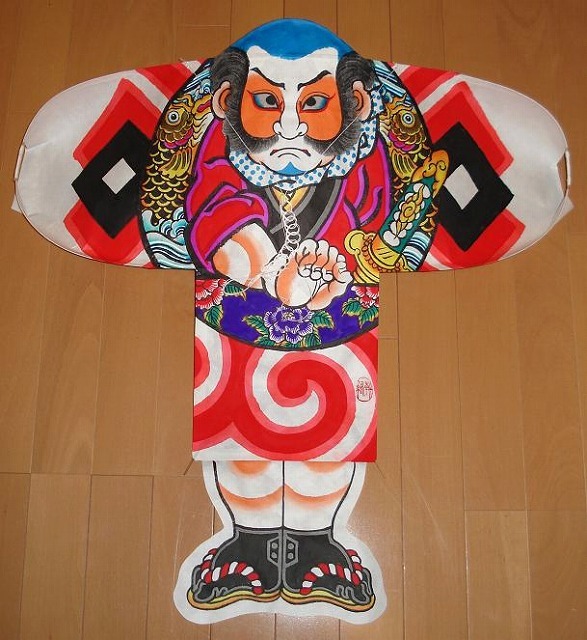
※画像引用 https://kobo-toki.com/
源兵衛さん:これができた理由をみんな知らない。奴は最下層。大名行列で一番前で踊っている。奴はある意味軽蔑される立場。それを凧であげる。
江戸の街は約70%が大名屋敷だった。残りの30%にみんな住んでたわけ。奴を大名邸の上にあげることで、奴という最下層が大名を見下ろす遊び。奴凧をあげて命がけですごい勢いで逃げる。
私:命がけの遊びですね。でも凧揚げた瞬間きもちいいでしょうね。笑
「全身刺青」
源兵衛さん:昔江戸はみんな墨を入れた。駕籠かきは女の人をのせるやん。当時はみんなふんどし一丁でほぼ裸。全身刺青でかっこええ男の籠に女性が乗るわけ。
始まりは「モテたい」というシンプルな理由
全身刺青の話から「男性が女性にモテたい気持ち」は昔からシンプルで同じだと言う話になりました。
私:例えば有名なミュージシャンが音楽を始めたきっかけを聞いたら、ただ中学時代にモテたかったからギター始めましたみたいな感じですね。本当にシンプル!
源兵衛さん:当時の江戸は70%以上が男。男は自由に江戸に出入りできた。仕事も多かったから。
でも当時女の人は地元から移動できなかった。地元から動くことははしたない。あんたらみたいに日本人かカナダに行くなんてとんでもない。自分の村から外でに出ることをしない人がほとんどだった。社会の風潮よ。うろちょろしたら嫁に行けないわけ。
だから東京は男の街。男に対して女の数が少ない。だから奴凧をあげたり、破れ格子を着る。男らしいとモテるんよ。
私:その時から女性は少し悪い男に惹かれやすいわけですね。笑
源兵衛さん「粋」という言葉。関西では「すい」「息」という両方の意味よ。
「生き生きと生きている」からきている。生き生きと生きている男がかっこいい。幕府の弾圧に抵抗するような男がかっこいいわけ。
現代人は物事を複雑化しすぎ。全てはシンプル。
私:本当に単純ですね。人間って昔から生物的な部分は変わらないし一緒ですね。
源兵衛さん:本当に単純なんよ。例えば、さっき話した「全身刺青」の始まりは「火消し」なんよ。当初はナンバーを刻印で入れていた。ただ江戸の火事で自分が黒こげになって死んだ時にナンバーがわからないと、家族が誰かわからない。それがあんまり寂しいやないかということで、どこが焼け残るかわからないから全身刺青を入れたのが始まり。
今の人はぐちゃぐちゃくだらん情報を持ちすぎているから、単純に物を考えられへんから昔に近づけへんのや。物凄い単純なんよ。もっと縄文とかに行けばもっと単純。複雑なこと考えてられてん。生きるか死ぬかやから。
私:でもだからこそ後に残るし、人が心を動かされるわけですね。
源兵衛さん:今の人間は死が遠のいているからそのシンプルさがなくなってんねん。
私:そう!自分もなくなる時あります!頭でばっかりものを考えて。
源兵衛さん:そうやろ。頭ばっかりやねん。身体性がないねん。身体性になってくると動物と一緒やから物凄いシンプル。僕猟犬2匹飼っているんやけど、彼らが良い先生。
情報を情報と勘違いしている人が多い。人が情報を選ぶのではなく、情報が人を選ぶ。
源兵衛さん:くだらん情報を情報と勘違いして頭に詰め込んでる人らは、そこに辿り着けへんわけや。情報を勘違いしてんねん。人が情報を選ぶものと違うなん。情報が人を選ぶねん。
私:あー耳が痛い!!私、とにかく情報をたくさん仕入れて準備しなきゃ!と意気込んで疲れる時があります。でも結局それは不要な情報だったり。振り回されたり。
源兵衛さん:例えば僕も今喋ってて、徐々にああこういうこと言っても分かりそうやなとか測っているわけやん。これいうても無理やなと思ったら喋らんへんやん。情報が人を選んでるんや。
俺に物理学者が量子力学の物凄い難しいこと言われてもわからへんし、相手も喋らへんやん。
ただの観光地ではない本当の「京都」とは?
バンクーバーに到着した初日から、観光客のような過ごし方はしたくない。留学生にもなりたくない。バンクーバーで仕事をして生きている人々のリアルな経験がしたいと思い現在に至る私。
そして今回2年ぶりにバンクーバーから一時帰国し、数年ぶりに京都に行き、あまりの観光客の多さと観光客用の雰囲気に違和感を覚えていました。そんななか源兵衛さんから「ただの観光地ではない本当の京都とは?」の答えをお聞きすることができました。
源兵衛さん:くだらん情報をとっぱらって、シンプルさを辿っていった時に、京都って一体どういう街やったんかがわかってくるやん。そういう歴史の上に千年の都があったわけやん。
京都といえば「金閣寺」や「清水寺」とみんな思っている。そういうことじゃない。
源兵衛さん:これね、大徳寺の雲水で修行している人の下駄なんよ。みんな真っ直ぐに減っているでしょ。真っ直ぐに歩いているから。歩くのも修行なんよ。京都に来た人はこういうところを見るべき。ここには大体15から20人の修行僧がいる。最低3年間はいないかん。15年や20年いる人もいる。
源兵衛さんが実際に体験したお寺での修行のお話
そして、そこから源兵衛さんが実際に体験したお寺での修行のお話に。
源兵衛さん:毎朝、起きて5分で歯磨いて顔洗って、それから座禅4時間やらされる。朝3時に起きる。それで7時まで座禅よ。その後とにかく食事して(飲まず食わずをする人もいるけど)それから草をむしったり、掃除をする。
座禅中は目を半分にして1.5m向こうをみる。目を完全に閉じると色んなことを考えるから。目をちょっと開けている方が集中する。半眼にする。それで4時間。何も考えなくなれば大したもんよ。
私:絶対私だったら他ごとすぐ考えちゃう!
源兵衛さん:例えば、仏像があるやん。「お前仏像を見て何を感じる?」と聞かれる。ちょっとええカッコしてなんかいうやん。そしたらバシッと叩かられる。
私:何を答えればいいんですか?
源兵衛さん:「耳が大きい」とかそういう答え。小学校2年までに戻れっちゅう修行なんよ。
源兵衛さん:曹洞宗は問答いらずで問題が出ない。臨済宗は問答がある。この問題が難しい。解けたら、老師の部屋に行って答えを言う。24時間ノックして良い。でも「わかっとらん」の一言。それくらい難しいねん。27年間考えている人もいんねん。それは答えがないねん。考え方なんよ。そこの考え方まで行きついてるかどうか。
「犬に仏性があるかないか」とかそんな問題よ。
修行に来る方々の理由とお寺の真の存在意義
源兵衛さん:僕の隣の部屋人は「やっぱり死ぬます」と書き置きがあった。死のうと思ったけどもう一回寺に行ってと思ったんやろうな。そやけどやっぱり自分は死にますと。
そんなにあまないねん。本当にみんな深刻なんよ。その深刻な思いでみんな集まってねん。ある女性は障害者のある子供を生んで、さらに二人目も障害者。旦那は逃げてしもって。そういう人がそのお寺に来るんよ。
生きていくべきか、もう3人で死んだ方が良いか。そういう意味でお寺ってもの凄い意味があったんよな。今でもそういう人にとってはもの凄い意味があんねんやけど。それがお寺があれだけの立派なものを建てたり、人が本気でお参りにいった理由やんか。
それが今観光名所になっている。それで漫才みたいな坊さんが出てきて、面白いこというたり。
私:時々動画やTVで見ますけど、お坊さんがまるで観光業になっているように感じるシーンが多々ありますね。でも観光客の方々も浅い部分で満足してしまう人がほとんどなんでしょうね。
源兵衛さん:そう、ただものを見にいってんねん。でも大徳寺の雲水や永平寺も三日とか1週間の修行コースがあるよ。
私:色んなお寺を巡るよりも修行体験をして少しでもお寺の真の存在意義や、修行僧の方々の生活が理解できれば、本当の京都を垣間見ることができますね。
源兵衛さん:土産もんレベルの京都、土産もんレベルの日本がほとんど。でも出来ればもうちょっとマシな日本、京都を見ようよと。まあ京都もどんどん無くなっていっているけど。でもそれが多少自分の意識の中にあると少し見え方が変わってくるやん。
そういうことを求めている人もいると思う。本当の日本を全ては無理だけどちょっと味わいたい人もいると思う。
源兵衛さんへのインタビューの続きは第二弾で
源兵衛さんからお聞きした日本人として知っておくべき興味深いお話はまだまだ続きますが、今日はこの辺でお暇いたします。ちなみにこちらの写真は源兵衛さんのオフィスの奥にある美しいお庭。思わずため息が出ますよね。
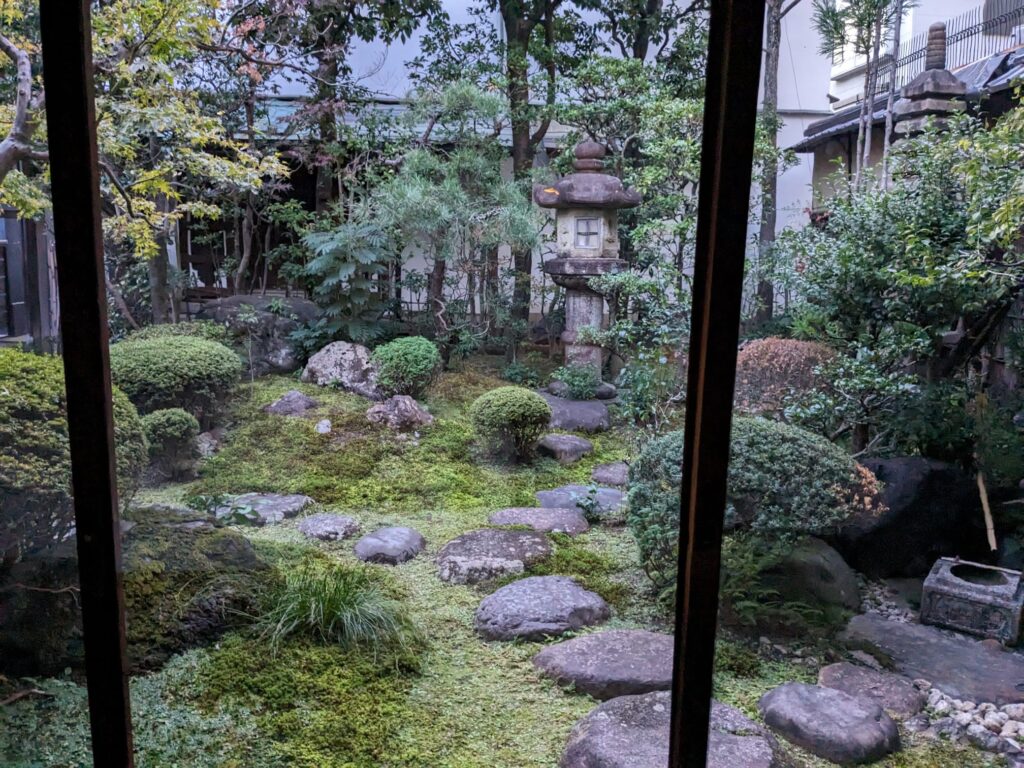
この記事を読んでいただいた日本人の方が日本の文化に誇りを持ち、深く理解するきっかけになりますように。そして自国を愛する心がさらに芽生えますように。
海外の方が、日本の文化に興味を持ち、真の魅力と奥深さの虜になるきっかけになりますように。
そしてそれが、失いつつある日本の美しい文化を守る小さな力添えに繋がりますように。
第二弾も近日中に執筆しますので、是非ご一読ください!
Interview with Mr. Yamaguchi Genbei, 10th Generation of the Esteemed 285-Year-Old Obi Manufacturing and Sales Company, Kondaya Genbei, in Kyoto Part 1
The Miracle That Happened During My Temporary Return to Japan in November
Meet Yamaguchi Genbei, the 10th generation head of the obi (traditional Japanese belt) craftsman “Kondaya Genbei,” which was established about 285 years ago in Kyoto’s Muromachi district.
It is referred to as the maverick of the industry, boasting fervent devotees both domestically and internationally.
I first learned about Genbei when my partner Joseph stumbled upon a video of Genbei’s obi on YouTube. I was captivated the moment I saw the boldly woven obi featuring peonies using lapis lazuli on the jet-black fabric introduced in that video.
For more information, you can visit the official website of Kondaya Genbei: https://kondayagenbei.jp
Upon deciding to temporarily return to Japan at that time, I made up my mind to see his obi in person. When I visited Kyoto in November, I called the office of “Hodataya Genbei” directly. Through a series of fortunate events and coincidences, I was lucky enough to have the opportunity to directly admire Genbei’s obi, which is not usually open to the public.
But that’s not all! On that day, by sheer chance, Genbei happened to be at the office, and I was granted the privilege of having a direct interview with him. The person who answered the phone also repeatedly mentioned how it was a “miracle.” I sincerely appreciate the valuable time given to me by Genbei and all the staff at “Kondaya Genbei,” and I am truly grateful for this miraculous experience.
In this Part 1, before delving into the topic of belts, I will first write about the history of Japan and delve into the thought processes of people at that time based on the interview with Mr. Genbei. Additionally, I will explore the essence of Kyoto beyond its tourist attractions.
Genbei shared aspects of “Japanese history” that are not found in textbooks.
Here is the office and studio of “Kondaya Genbei.” I was guided into a dimly lit, atmospheric room hidden in the depths of a charming Japanese-style house. In that room, Genbei sat in the back, emanating an overwhelming aura, and I was immediately captivated by his deep, resonant voice.
The purpose of Japanese textiles is “dignity.”
Mr Genbei: It is said that the purpose of Japanese textiles was “dignity,” and the Heian period was an incredible era. This is a story about some members of the aristocracy, where everyone would bow their heads in reverence solely at the dignity of the fabric worn by the Emperor.
Expressing “dignity” is remarkable, I think. The original textiles and patterns were influenced by Chinese worship because of various items brought back by missions to Sui and Tang. At that time, motifs often featured flowers and plants not found in Japan.
What’s interesting is that when there were issues and trade with China was discontinued, Japanese style emerged. Since they couldn’t replicate the costumes, Japanese adaptations began. The true costumes that remain date from the Momoyama period onwards, primarily those worn by individuals like Oda Nobunaga and Uesugi Kenshin. Unfortunately, only a few costumes of certain individuals have survived, leading to gaps in costume history.
Therefore, it’s necessary to rely on literature and paintings to make educated guesses. Furthermore, there are no remnants of costumes from the Heian period. However, it is evident that during the Heian period, “dignity” was placed at the pinnacle.
The reason “dignity” was held in high regard during the Heian period and the definition of “dignity” as “cultivation.”
Mr. Genbei: That was because there was no “military force” at the time. During that period, “information and cultivation” held more power than military force. Military strength was looked down upon.
Me: How is “dignity” measured then?
Mr. Genbei: “Dignity” is synonymous with “cultivation.” It’s about how much you know, for example, about China.
Me: So, it was a peaceful era?
Mr. Genbei: It was peaceful, but mentally challenging. It was a period of impure thoughts. If a single cat died in the Imperial Palace, politics for that day would come to a halt. For instance, if the emperor fell ill, they would confine him to a shanty.
There were epidemics, similar to what we call COVID nowadays. The fear of invisible bacteria was intense. That’s why common people couldn’t meet the emperor. All information gathered around the emperor. Some extraordinary information could only be found there. Buddhism and Chinese characters came from the continent. These were more important than military force.
Also, many people misunderstand that aristocrats didn’t practice martial arts, but they did engage in formal martial arts. People considered samurai to be even lower than dogs. So, samurai eventually fought back. They, too, initially imitated the martial arts of the aristocracy, but merely practicing the formal version would get them killed. That’s why samurai in the Kamakura period were remarkable; they incorporated the aristocrats’ spiritually dignified martial arts while embracing the wild, practical aspects.
“Kabuki” originated as a place to purchase beautiful young men.
And the conversation shifted to “Kabuki”… Mr. Genbei shared surprising truths that I had not learned from textbooks.
Mr. Genbei: When I investigated screen paintings from the Momoyama period, it turned out that nobody was watching Kabuki. Everyone was engrossed in Noh performances. In Kabuki, people were just drinking. It was a place to buy young boys.
But back then, it was something you couldn’t openly talk about. That’s the complicated part of history. Ultimately, since it doesn’t get mentioned in textbooks, most people are unaware.
Kabuki originated as a place to procure beautiful young boys, and in part, beautiful young girls. Historically, it was an era marked by a strong culture of affection for beautiful boys and girls. From the Kamakura period onwards, male-male love was commonplace. Female-female love was associated with rural paths, while male-male love was considered the sophisticated path, especially among the samurai, where it was regarded as a refined inclination.
During the Edo period, “Kabuki” served as a satirical medium to mock the shogunate.
The origins of “Kabuki” as a place to buy beautiful young boys evolved over time, and it gradually transformed into a media platform that entertained audiences by satirizing the shogunate during the Edo period.
Mr. Genbei: The first-generation Danjuro was brutally murdered, and the second generation didn’t have a decent death either. Because they mocked the shogunate, constant oppression from the Tokugawa shogunate ensued, and they would get caught, trampled on, or even arrested. There were several Kabuki theaters in Edo, and they were always packed every day. When you do something like that, people gather. However, if you go too far, like Danjuro, you might end up killed.
Me: So, Kabuki actors were risking their lives. They would change names and stories, carefully navigating the thin line to criticize the shogunate.
The origins and reasons behind “torn lattice,” “yakko kites,” and “tattoos.”
Torn lattice
This is one of my favorite videos posted on Mr. Genbei’s Instagram.
Mr. Genbei: This pattern has been around for about 350 years, meant to defy the shogunate. The lattice represents the shogunate, and breaking it signifies opposition. The symbolic pattern of overthrowing and opposing the shogunate. It represents the defiance of the order upheld by the shogunate.
Even if someone is wearing this, the shogunate understands the meaning of the pattern, but it’s a close call whether they get caught or not.
Yakko Kite

※Image source https://kobo-toki.com/
Mr. Genbei: The reason why this was created is unknown to everyone. A “Yakko” represents the lowest social class. They dance at the front of the daimyo’s procession, yet they hold a somewhat scorned position.
The kite is raised to elevate the Yakko In the Edo city, around 70% was occupied by daimyo residences, and the remaining 30% was where everyone else lived. By lifting the Yakko kite above the daimyo’s mansion, it becomes a game where Yakko, the lowest class, looks down upon the daimyo. They fly the Yakko kite and then escape at great speed, risking their lives.
※Daimyo” is the term used in English to describe the historical Japanese feudal lords. In Japan’s history, particularly during the Warring States (Sengoku) period and the subsequent Edo period, the daimyo were powerful regional rulers who held land and exercised military and administrative control over their domains. The term “daimyo” is commonly used to refer to these feudal lords in the English language when discussing Japanese history.
Me: It sounds like a dangerous game. But I bet it feels exhilarating the moment the kite goes up…
Full Body Tattoos
Mr. Genbei: In the past, everyone in Edo had tattoos. Kago-kaki is when women are carried in a palanquin. At that time, everyone was almost naked, wearing only loincloths. Having a woman with full-body tattoos ride in the palanquin of a strikingly tattooed man was a way of showing off.
It all started with a simple reason: “I want to be popular.”
From the discussion about full-body tattoos, the conversation shifted to the idea that the desire for men to be popular with women has remained simple and consistent throughout history…
Me: For example, if you ask a famous musician about the reason they started playing music, it might be something like, “I wanted to be popular in middle school, so I started playing the guitar.” Really simple!
Mr. Genbei: At that time, Edo had a population that was over 70% male. Men could freely come and go from Edo, and there were many job opportunities.
But women couldn’t move from their local areas. Moving from one’s hometown was considered improper. It’s unimaginable for someone like you to go to Japan or Canada. Most people back then didn’t venture outside their village; it was a societal norm. If you wandered around, you wouldn’t find a husband.
So, Tokyo was a city for men. There were fewer women compared to men. So, they fly kites or wear tattered lattice-patterned clothing. It’s considered manly and attractive.
Me: From that time, it seems like women have been attracted to slightly rebellious men. (laughs)
Mr. Genbei: The word “iki” is used. In Kansai, it means both “cool” and “breath.” It comes from “living lively.” A man who lives lively and stands out is cool. A man who resists the oppression of the shogunate is cool.
Modern people tend to complicate things too much. Everything is simple.
Me: It’s truly simple, isn’t it? The biological aspects of humans have remained the same since ancient times.
Mr. Genbei: It’s really simple. For example, the origin of “full-body tattoos” I mentioned earlier is from “firefighters.” Initially, they used to engrave numbers on their bodies. But during a fire in Edo, if you turned into a blackened corpse and your number couldn’t be identified, your family wouldn’t know who you were. Because that was considered quite lonely, they started getting full-body tattoos since they didn’t know which part of their body would survive the fire.
People nowadays have too much messy and useless information, so they can’t think simply, which is why they can’t get closer to the past. It’s incredibly simple. If you go back further, like to the Jomon period, it’s even simpler. People think about complicated things. It’s about life and death.
Me: But that’s why it endures and moves people’s hearts later on.
Mr. Genbei: Nowadays, humans are distant from death, so that simplicity is lost.
Me: Exactly! There are times when I lose sight of that! Always thinking in my head.
Mr. Genbei: That’s right. It’s all in the head. There’s no physicality. When you become more attuned to your physicality, it’s incredibly simple, like animals. I have two hunting dogs, and they are great teachers.
Many people misunderstand information as information. It’s not that people choose information; rather, information chooses people.
Mr. Genbei: People who mistake trivial information for valuable knowledge and cram it into their heads won’t reach anywhere. They are misunderstanding information. It’s different from people choosing information; information chooses people.
Me: Ah, that hits close to home! Sometimes I get so caught up thinking I have to gather a lot of information and be prepared, but it often turns out to be unnecessary information. I end up exhausted or tossed around.
Mr. Genbei: For instance, even as I speak now, I’m gauging how the audience might react or understand certain things. If I feel it’s not working, I won’t continue talking. Information is choosing people.
If a physicist starts talking to me about highly complex quantum mechanics, I won’t understand, and if they notice that, they won’t keep talking. Information is choosing people.
What is the true essence of Kyoto, which is more than just a typical tourist destination?
From the first day of my arrival in Vancouver, I didn’t want to experience it like a typical tourist. I didn’t want to become just another exchange student either. I aspired to have a real experience, living and working among the people in Vancouver. This sentiment has guided me up to the present moment.
Upon returning temporarily from Vancouver after two years, I visited Kyoto for the first time in several years. I couldn’t help but feel a sense of discomfort amidst the overwhelming number of tourists and the tourist-oriented atmosphere. In the midst of this, I had the opportunity to ask Genbei about the true Kyoto that goes beyond being just a tourist destination.
Mr.Genbei: By stripping away trivial information and following simplicity, you come to understand what kind of city Kyoto really is. It’s a city built on a thousand years of history. When people think of Kyoto, they often associate it with places like the “Golden Pavilion” or “Kiyomizu Temple.” But it’s not about that.Genbei: You see, these are the geta (wooden clogs) of the monks practicing zazen at Daitoku-ji. Everyone walks in a perfectly straight line. They walk straight, and walking itself is a form of training. Those who come to Kyoto.
The Story of Genbei’s Actual Temple Training Experience
And then, let me tell you about Genbei’s actual temple training experience.
Mr. Genbei: Every morning, I wake up, brush my teeth, wash my face in five minutes, and then I’m forced to do zazen (sitting meditation) for four hours. I wake up at 3 a.m. and sit in meditation until 7 a.m. After that, we have a meal, and some people choose to fast. Then we may weed the garden or engage in cleaning.
During zazen, you keep your eyes half-open, gazing about 1.5 meters ahead. Closing your eyes completely leads to various thoughts, so keeping them slightly open helps with concentration. And that goes on for four hours. It’s quite an accomplishment when you reach a point of not thinking about anything.
Me: I would definitely start thinking about other things right away!
Genbei: For instance, there’s a Buddhist statue. They might ask, “What do you feel when you look at the Buddhist statue?” You might try to say something clever, but then you get a swift strike.
Me: What should one answer?
Mr. Genbei: Something like “The ears are big.” It’s a practice of going back to the mindset of a second-grader in elementary school.
Mr. Genbei: In the Soto school, there are no questions and answers, no problems. In the Rinzai school, there are questions and answers. The questions can be quite challenging. Once you solve them, you go to the room of the master and give your answer. You can knock on the door for 24 hours, but the response is just, “Go back.” It’s that difficult. Some people spend 27 years contemplating, and there’s still no answer. It’s about the way of thinking, whether you’ve reached that level of thinking.
Whether a dog has Buddhahood or not, those are the kinds of questions.
The reasons people come for training and the true significance of the temple
Mr. Genbei: the person in the room next to mine left a note saying, ‘I’ve decided to die after all.’ They must have thought about it, but then considered going to the temple one more time. However, in the end, they wrote that they will still go through with it.
It’s not that rare, you know. Everyone is genuinely struggling. People gather with such serious intentions.
A woman gave birth to a child with a disability, and the second child also had a disability. Her husband ran away. Such a person comes to this temple.
Should they continue living, or is it better for the three of them to die together? In that sense, the temple holds immense significance. Even now, it holds incredible meaning for people in such situations. That’s why temples build such impressive structures and why people sincerely visit them.
Now they’ve become tourist attractions. Comedic monks appear, saying amusing things.
Me: I occasionally see scenes like that in videos or on TV, where it feels like monks have turned into a tourist industry. But I guess most tourists are satisfied with just scratching the surface.
Mr. Genbei: Yeah, they’re just there to see something. But places like Kodai-ji and Eiheiji offer three-day or one-week training courses.
Me: Instead of touring various temples, if people could experience the training and understand even a bit of the true significance of temples or the lives of practicing monks, they could catch a glimpse of the real Kyoto.
Mr. Genbei: Kyoto has become more of a souvenir-level Kyoto, almost like a souvenir-level Japan. But if possible, let’s try to see a bit more of the authentic Japan, Kyoto. Well, Kyoto is also gradually disappearing. But having that awareness in your mind can change your perspective a bit.
Some people are seeking that. It might be impossible to experience all of the real Japan, but some people just want a taste of it.
To Mr. Genbei, the continuation of the interview will be in Part 2
The fascinating stories that Mr. Genbei shared as a Japanese individual continue, but for today, we will conclude here. By the way, the photo here captures the beautiful garden at the back of Mr. Genbei’s office. It’s enough to make you sigh involuntarily.
I hope that this article inspires Japanese readers to take pride in and deepen their understanding of Japanese culture. May it also foster a greater love for one’s own country.
For international readers, I hope it sparks an interest in Japanese culture, captivating them with its true charm and depth.
Furthermore, may this contribute as a small support in preserving the vanishing beauty of Japanese culture.
Stay tuned for Part 2, which will be written soon. Please be sure to give it a read!

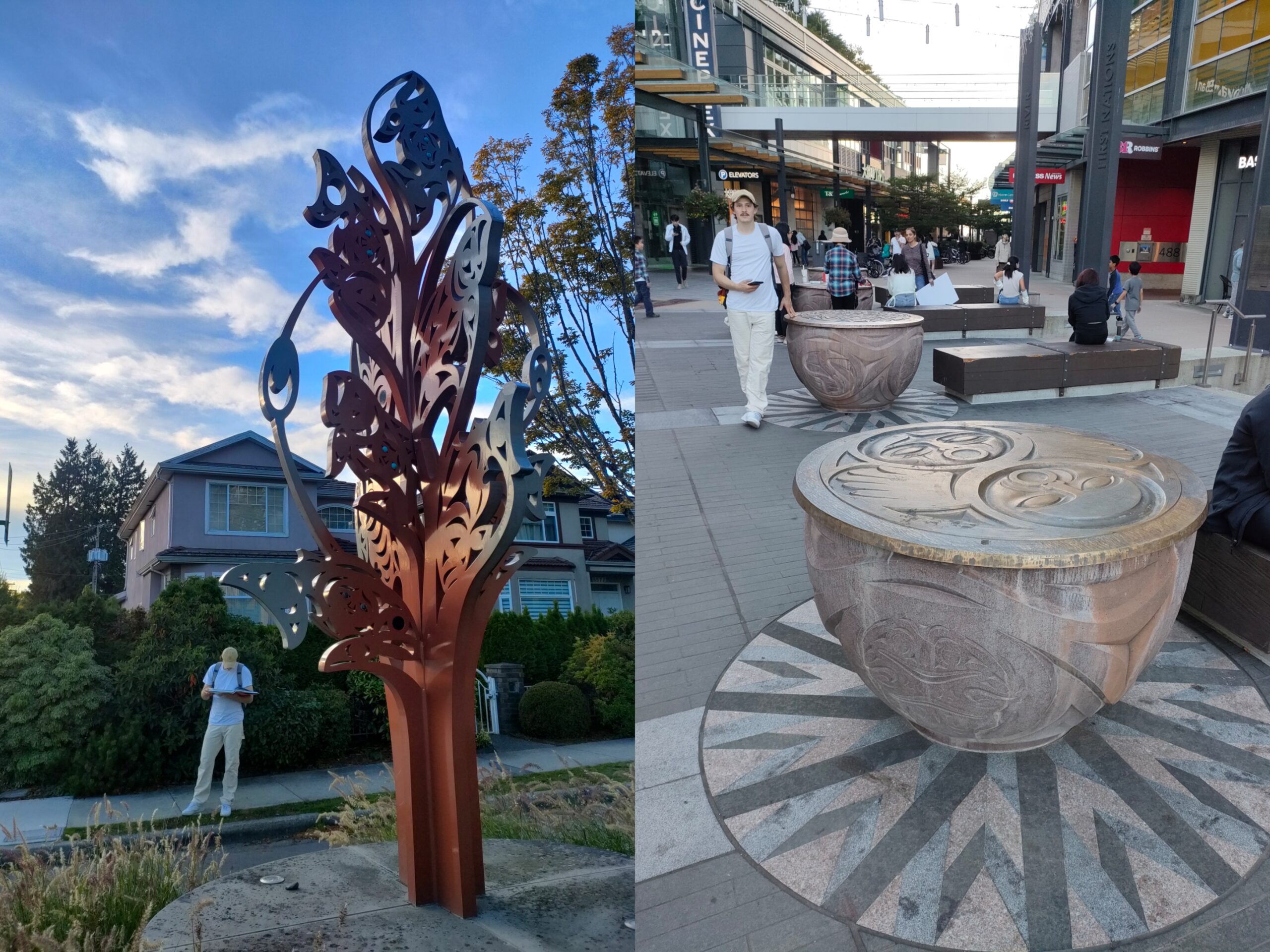

コメント